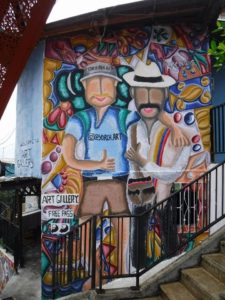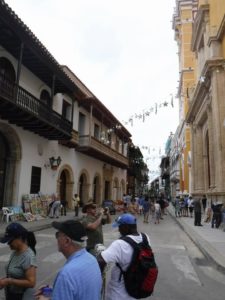-
From Coffee to Cartagena, Colombia has it all.
Well, it turns out Juan Valdez, the world-famous mascot for Colombia coffee, was created by a Miami advertising agency in 1959 in what became a highly successful attempt to brand Colombian coffee. The folks in Miami could not differentiate between the individual Latin American countries, so they chose “Juan” as a generic first name. Ok on that, but no one in Colombia is named “Valdez,” as it’s not a Colombian name. To add insult to injury, the Miami folks chose a Cuban actor to play Juan and represent the brand for a decade. Further, no real Colombia coffee worker (or any coffee worker, for that matter) bears the slightest resemblance to Juan´s sartorial splendor. Other than that, they nailed it. Today, Juan is played by a Colombian, but he still dresses far too well.
Now, about coffee.
After you take this tour through the Café Morelia coffee plantation, you´ll switch to tea out of sheer guilt. You see, the beans must be harvested by hand, a backbreaking process that takes place every 15 days, and the workers are paid a pittance, no more than $8 for a 14 plus hour day. Although a lot of people work very hard, shown by the fact that Colombia exports 30 million sacks of coffee a year, the industry is in trouble, for several reasons. First, in 1991, the government instituted free public education, so many people jumped at the chance to get out of the fields. Second, the land is too valuable to be used to grow coffee, so condos are being built on it. Third, farmers are moving into avocado farming, which is much higher profit for much less work. Last, global warming has affected the climate, and Colombia is feeling the effects severely. As a result, only the very young, very old, and very poor can afford to do this work, Drink up, folks, because that cuppa joe is going to rise in price pretty soon. In fact, Colombia has to import coffee for its citizens to drink, as it exports as much as they can to generate money.
Three Coffee Crimes in Colombia
- Adding sugar to coffee. This is nonetheless very common in Colombia because the country exports its best beans and saves to worst for its citizens. As a result, people add an unconscionable amount of sugar to their coffee to cover the bitter burnt taste of the rejected beans and make the drink palatable.
- Drinking instant coffee. This is self-explanatory.
- Drinking decaf coffee. After you learn about the chemicals used to make decaf, you’d never drink it again, either. Then again, you’d already have switched to tea.

About 20 years ago, Comuna 13 (District 13) was Colombia`s most notorious neighborhood, known for its astronomical homicide rates and forced displacement of thousands of residents. The region was the epicenter of paramilitary, guerrilla, and gang activity because of its hilly geography and location, as it leads directly to the main highway (San Juan Highway), providing easy transportation of guns, drugs, and money. Today, District 13 is no longer part of the Hunger Games. The citizens have reclaimed their town, making it an artistic center visited by dignitaries far and wide, including President Clinton. The art is graffiti murals.
Cartagena, Colombia
A few things I learned while touring Cartagena…
- In Cartagena, baseball –rather than soccer– is the number one sport. Colombia has sent 19 players to the major leagues, including Orlando Cabrera and Jose Quintana. I actually knew this, as we have superb baseball players at the Farmingdale State College and I’d actually looked up “Famous Baseball Players” in Wikipedia.
- Cartagena was founded in 1533 by the Spanish, largely because of its excellent ports. The city soon became a center for trade in gold, silver, and slaves.
- Shakira, Justin Beiber, and Lady Gaga all have homes here. Gabriel Garcia Marquez, Nobel Laureate, lived here, too. Can you guess which of these people most impressed me? (Hint: Not the first three, especially the Beebes.)
- The city is gorgeous and smells like coffee. It`s very Spanish, as you would expect, with beautiful balconies, brilliant flowers, and small shops.

A street in Cartagena
Along the way, we visited the Castillo San Felipe de Barajas, the famous Cartagena fort. One of the fellow travelers asked why the fort had been built. Two theories: To repel invaders or to attract tourists? Given the great photo ops, I´d go with the later theory. We schlepped up the steps, we schlepped down the steps, all the while trailed by vendors selling key chains, scarves, hats, sunglasses, cold water, and refrigerator magnets.

